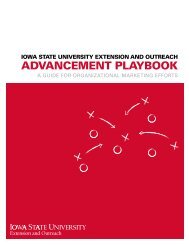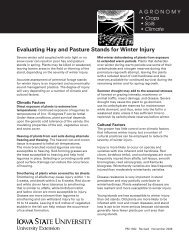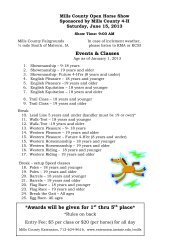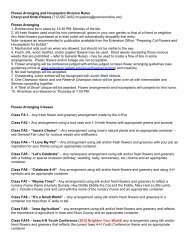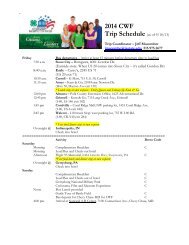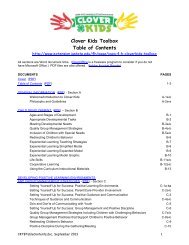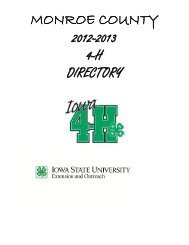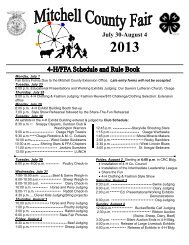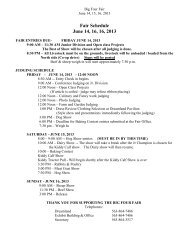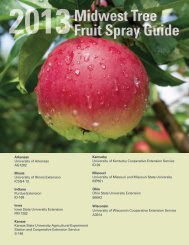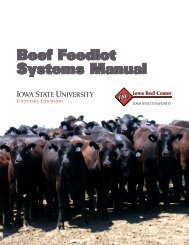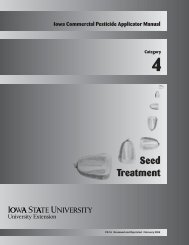Afterschool Snack Guide
Afterschool Snack Guide
Afterschool Snack Guide
Create successful ePaper yourself
Turn your PDF publications into a flip-book with our unique Google optimized e-Paper software.
<strong>Guide</strong> <strong>Guide</strong><br />
<strong>Snack</strong> After-school<br />
After-school<br />
Healthy Healthy<br />
Directors<br />
Nutrition Nutrition<br />
School School for After-School<br />
After-School<br />
Energizing Energizing<br />
This supplemental resource is part of<br />
ReCharge!<br />
the After-school Program from Action for Healthy Kids and National Football League
Energizing<br />
Energizing After-School<br />
After-School<br />
Action for Healthy Kids draws upon the expertise and contributions of numerous<br />
national organizations, government agencies, Action for Healthy Kids State Teams<br />
and individuals committed to creating schools that promote sound nutrition and<br />
physical activity. The following members of the Action for Healthy Kids Partner<br />
Steering Committee, State Teams and after-school experts provided valuable<br />
guidance, information and critical review for this program.<br />
AFTERSCHOOL ALLIANCE<br />
Della Cronin<br />
AMERICAN ALLIANCE FOR HEALTH,<br />
PHYSICAL EDUCATION, RECREATION AND DANCE<br />
Judith C. Young, PhD<br />
AMERICAN ASSOCIATION OF FAMILY<br />
AND CONSUMER SCIENCES<br />
Beverly Card, CFCS, NBCT<br />
AMERICAN DIETETIC ASSOCIATION<br />
Jessica Donze Black, RD, MPH<br />
ASSOCIATION OF STATE AND TERRITORIAL<br />
PUBLIC HEALTH NUTRITION DIRECTORS<br />
Maria Bettencourt<br />
CHILDREN’S HUNGER ALLIANCE &<br />
OHIO ACTION FOR HEALTHY KIDS<br />
Shelly Roth, MPH, RD, LD<br />
COUNCIL OF CHIEF STATE SCHOOL OFFICERS<br />
Nancy Hudson, RN, MS, CHES<br />
DENVER PUBLIC SCHOOLS<br />
Donna Wittrock, MS, SFNS<br />
FAMILY, CAREER AND COMMUNITY<br />
LEADERS OF AMERICA<br />
Sandy Spavone<br />
FLORIDA DAIRY COUNCIL<br />
Jennifer Whittaker, MPH, LD/N<br />
FLORIDA DEPARTMENT OF HEALTH<br />
Elizabeth Levenduski, MS, RD, LD/N<br />
FOOD AND NUTRITION SERVICE, USDA<br />
Julie Stauss Fort, MPH, RD<br />
FOOD RESEARCH AND ACTION CENTER<br />
Crystal Weedall FitzSimons<br />
Nicole Woo<br />
LA CROSSE SCHOOL DISTRICT (WISCONSIN)<br />
Marilyn Hurt, SFNS<br />
NATIONAL PTA<br />
Melissa Ganley, MA<br />
NATIONAL ASSOCIATION FOR SPORT<br />
AND PHYSICAL EDUCATION<br />
De Raynes, MA, EdS<br />
NATIONAL ASSOCIATION OF<br />
ELEMENTARY SCHOOL PRINCIPALS<br />
Margaret Evans<br />
NATIONAL ASSOCIATION<br />
OF SECONDARY SCHOOL PRINCIPALS<br />
Jeff Sherrill, BS<br />
NATIONAL ASSOCIATION OF STUDENT COUNCILS<br />
Rocco Marano, MS<br />
NATIONAL COALITION FOR<br />
PARENT INVOLVEMENT IN EDUCATION<br />
Sue Ferguson<br />
NATIONAL DAIRY COUNCIL ®<br />
Carole Clemente, BA, ECE<br />
Tab Forgac, MS, RD, LD, SFNS<br />
Camellia Patey, MS, RD, SFNS<br />
NATIONAL FOOTBALL LEAGUE<br />
Cedric Jones<br />
Scott Lancaster<br />
Jenn Magner<br />
NATIONAL MIDDLE SCHOOL ASSOCIATION<br />
Jean Schultz, MS, CHES<br />
NATIONAL SCHOOL BOARDS ASSOCIATION<br />
Elizabeth Partoyan<br />
NATIONAL URBAN LEAGUE<br />
Velma Cobb, PhD<br />
POLK COUNTY SCHOOLS (FLORIDA)<br />
Marcia Smith<br />
PRESIDENT’S COUNCIL<br />
ON PHYSICAL FITNESS AND SPORTS<br />
Christine Spain, MS, MA<br />
SCHOOL NUTRITION ASSOCIATION<br />
Ev Beliveau, RD, SFNS<br />
Gigi Alterio-Compton, CCP<br />
SOCIETY OF STATE DIRECTORS OF HEALTH,<br />
PHYSICAL EDUCATION AND RECREATION<br />
Sharon Murray, MHSE, CHES<br />
We are grateful to the following school<br />
districts for pilot testing this program.<br />
Alief Independent School District (Texas)<br />
Archdiocese of Chicago<br />
Bullitt County Public Schools (Kentucky)<br />
Chicago Public Schools<br />
Duvall County Public Schools (Florida)<br />
Galena Park Independent School District (Texas)<br />
Houston Independent School District (Texas)<br />
Independence 30 (Missouri)<br />
Jefferson County Public Schools (Kentucky)<br />
Kansas City 33 (Missouri)<br />
Oldham County Schools (Kentucky)<br />
Pasadena Independent School District (Texas)<br />
Seattle Public Schools<br />
Shawnee Mission School District (Kansas)<br />
Spring Branch Independent School District (Texas)<br />
Syracuse City Schools (New York)<br />
Other Program Contributors<br />
Flair Communications<br />
Hartman Bourneuf & Associates<br />
Joyce Abercrombie,<br />
Project Management Consulting<br />
MMS Education<br />
Shattuck & Associates<br />
Portions of ReCharge! are available at no charge online at www.ActionForHealthyKids.org.<br />
© 2005 National Dairy Council ®<br />
© 2005 NFL Properties LLC. Team names/logos are trademarks of the teams indicated. All other NFL-related trademarks are trademarks of the National Football League.<br />
May be duplicated for educational purposes only.<br />
ReCharge! was made possible by an educational<br />
grant from National Dairy Council ® and other sponsors.
Feeding Children After-school<br />
With more parents working outside the home and the growing emphasis on academic achievement, the<br />
hours after school are increasingly filled with educational and enrichment programs. These programs can<br />
also play an important role in improving students’ health and wellness by providing nutrition education,<br />
physical activity and a nutritious snack.<br />
A healthy snack is an essential part of any after-school program. It gives children the boost they need to<br />
get through the afternoon and keeps them away from unhealthy alternatives. School nutrition departments<br />
can support student health and wellness by providing food for the after-school program.<br />
To make it easier for school nutrition departments to provide a nutritious snack, the United States<br />
Department of Agriculture (USDA) provides funding for snacks through the National School Lunch Program<br />
(NSLP). Additionally, funding is available to provide suppers as well as snacks through the Child and<br />
Adult Care Food Program (CACFP).<br />
NSLP <strong>Snack</strong>s<br />
School nutrition departments that participate in the NSLP can provide federally funded snacks<br />
to after-school programs — both school-based and in the community. The school nutrition<br />
department already has a working relationship with the state child nutrition agency that<br />
administers the NSLP and is familiar with the paperwork commonly required by the child<br />
nutrition programs. The school nutrition department also has the expertise, staff and facilities<br />
to produce nutritious snacks, making their help invaluable to the after-school program.<br />
After-school Program Requirements<br />
To receive NSLP funding for snacks, the after-school program must be school-sponsored, but<br />
it can take place on or off school grounds and can be operated by the school or by another<br />
organization such as a YMCA, a Boys and Girls Club or a religious congregation. The afterschool<br />
program must offer some educational and enrichment activities. Sports and recreation<br />
can be part of the program, but programs that are purely competitive sports teams, such as<br />
the high school varsity basketball team or a baseball league, are not eligible.<br />
Program Eligibility<br />
An after-school program qualifies for the NSLP by its location or the income of the children in<br />
the program:<br />
• If the program is located in a low-income area — where 50 percent or more of the<br />
elementary, middle or high school students qualify for free or reduced-price school meals<br />
— then the school receives the highest rate of reimbursement, called “the free rate,” for<br />
all of the snacks it serves to all children. Tens of thousands of schools meet this test.<br />
• If the program is not in a low-income area, then the school receives reimbursement in<br />
a three-tiered system (“free,” “reduced-price” or “paid”) based upon each participant’s<br />
school meal application.<br />
For the current snack reimbursement rates, visit:<br />
www.fns.usda.gov/cnd/Governance/notices/naps/NAPs04-05.pdf or<br />
www.frac.org/pdf/rates.PDF. The rates are adjusted annually for inflation.<br />
1
2<br />
Age Eligibility<br />
Children age 18 and under can receive snacks. If the student turns 19 during the school year, he<br />
or she is still eligible for the program.<br />
Program Administration<br />
The school nutrition department usually submits an addendum (supplied by the state) to its<br />
existing school meals application. The snacks must include two out of the following four components:<br />
milk, fruits or vegetables (including juice), grains or grain alternatives, and meat or meat alternatives.<br />
A few of the required amounts for snacks are slightly different from the school lunch requirements.<br />
A list of USDA’s nutritional requirements for snacks is available at:<br />
www.fns.usda.gov/cnd/<strong>Afterschool</strong>/factsheet.htm or<br />
www.frac.org/html/building_blocks/nutritionalguidelines.html.<br />
Programs are required to keep meal counts and attendance rosters. Even though the school district<br />
administers the NSLP, there is no requirement that the foodservice staff distribute the snacks,<br />
keep the attendance roster or take the meal count. Many schools train the after-school program<br />
staff to be responsible for these tasks in order to decrease labor costs.<br />
The school nutrition department must monitor each after-school program twice a year. The first<br />
review must be done within the first four weeks of operation. During the review, the department<br />
must determine the program’s compliance with counting and claiming procedures and with the<br />
menus. Examples of monitoring forms are included on in the “<strong>Snack</strong> Programs in Action” section<br />
of this guide (see page 5).<br />
The logistics of the snack program will in large part be determined by the school’s resources. The<br />
common design is for the cafeteria staff to put together the snacks and store them in a designated<br />
area within the kitchen or outside the kitchen. Perishable items are often stored in coolers. (A<br />
school nutrition department can work with the after-school program to raise funds for coolers or<br />
receive them as in-kind donations from local civic organizations, grocers, or children’s health and<br />
hunger agencies.) The after-school program picks up the snacks, serves them to the students in<br />
the cafeteria or another designated area, fills out the paperwork and cleans up the area afterwards.<br />
Leftover snacks often can be re-stored as long as the food is kept at the proper temperature.<br />
Additional information on logistics is explored in the “<strong>Snack</strong> Programs in Action” section of this<br />
guide.<br />
For additional information on NSLP snacks, visit:<br />
www.fns.usda.gov/cnd/<strong>Afterschool</strong>/default.htm or<br />
www.frac.org/Out_Of_School_Time/<strong>Afterschool</strong>/index.html.<br />
Even though the NSLP snack is available to any school participating in school<br />
lunch, some school nutrition directors may choose not to participate in the<br />
NSLP snack especially if a small percentage of low-income children participate<br />
in the program. Regardless of whether the school uses the child nutrition<br />
programs, it is still important that children receive a nutritious after-school<br />
snack. School nutrition departments can provide a healthy snack to the afterschool<br />
program and charge the program the cost of the snack if necessary.
Providing Suppers After School<br />
Providing a supper is a great way to support working families, to ensure that children are receiving<br />
enough nutrition to get through the afternoon, and to increase the financial viability of feeding children<br />
after school. The supper requires five nutritional components versus the two that the snack requires,<br />
but the free supper reimbursement rate is nearly four times the free snack reimbursement.<br />
Even though suppers are not available through the NSLP, school nutrition departments can provide<br />
suppers as well as snacks through the Child and Adult Care Food Program (CACFP). Seven states —<br />
Delaware, Illinois, Michigan, Missouri, New York, Oregon and Pennsylvania — are part of an afterschool<br />
supper program pilot project, which follows the same area eligibility rules as the snack program.<br />
After-school programs located in low-income areas in these states receive the free reimbursement rate<br />
for suppers served to children age 18 and under. Additional states that may join the pilot will be listed<br />
on FRAC’s website, www.frac.org.<br />
In other states (and in areas in the pilot states that are not low-income), children age 12 and under can<br />
receive federally funded suppers. Regardless of the location of the after-school program, children are<br />
individually qualified for free, reduced-price or paid meals. The school meals applications already qualify<br />
children for free or reduced-price school meals, so providing suppers with minimal additional paperwork<br />
is feasible.<br />
To provide suppers or snacks, the school nutrition director should speak with the state CACFP agency.<br />
A complete list of the state CACFP agencies and additional information is available at:<br />
www.fns.usda.gov/cnd/Contacts/StateDirectory.htm or<br />
www.frac.org/html/building_blocks/afterschoolcontacts.html.<br />
Additional Resources<br />
In 2004, the School Nutrition Association conducted a survey of nearly 500 child nutrition directors on<br />
feeding children after school. The survey found that 74 percent of respondents provided snacks<br />
through the NSLP and 11 percent offered food through the CACFP. It also calculated the average food<br />
costs for snacks (44 cents per snack), identified common logistical practices of schools and covered<br />
other helpful topics. It is a useful resource for any child nutrition director who is considering providing<br />
snacks after school. The full survey results are available at:<br />
www.schoolnutrition.org/uploadedFiles/ASFSA/newsroom/bookstore/pmsnackrpt04.pdf.<br />
The following websites offer additional information on the federally funded snack programs:<br />
• United States Department of Agriculture’s Food and Nutrition Services,<br />
www.fns.usda.gov/cnd/<strong>Afterschool</strong>/default.htm<br />
• Food Research and Action Center, www.frac.org<br />
• National Dairy Council’s Nutrition Explorations, www.NutritionExplorations.org<br />
3
Lowfat Yogurt (4 ounces)<br />
Orange (1 medium)<br />
Water<br />
Alphabet Shaped Pretzels (1 package)<br />
100% Orange Juice ( 3 ⁄4 cup)<br />
Cinnamon Bear Cookies (1 package)<br />
1% Chocolate Milk (1 cup)<br />
Lowfat Chocolate Milk (1 cup)<br />
Bagel (.9 ounces) with<br />
Light Cream Cheese (1 ounce)<br />
Graham Crackers (3 count)<br />
Lowfat Milk (1 cup)<br />
Yogurt (4 ounces)<br />
100% Orange Juice ( 3 ⁄4 cup)<br />
Cinnamon Toast (1 slice)<br />
100% Apple Juice ( 3 ⁄4 cup)<br />
Mozzarella String Cheese (1 ounce)<br />
100% Fruit Juice ( 3 ⁄4 cup)<br />
Mini Oatmeal Cookies (1 package)<br />
100% Blended Strawberry Yogurt (4 ounces)<br />
Mini Football Cookies (1 package)<br />
Lowfat Milk (1 cup)<br />
Lowfat Chocolate Milk (1 cup)<br />
Mixed Fruit in Light Syrup ( 3 ⁄4 cup)<br />
Petite Banana (1)<br />
Cheese & Peanut Butter Crackers (1 pack)<br />
Water<br />
Peanut Butter and Jelly Sandwich (1)<br />
100% Orange/Apple Juice ( 3 ⁄4 cup)<br />
Tiny Twist Pretzels (1 serving)<br />
Lowfat Milk (1 cup)<br />
Apple Pie Explosion Smoothie (1 apple)<br />
Graham Crackers (1 ounce)<br />
Red Delicious Apple (1)<br />
Teddy Grahams (1 package)<br />
4<br />
Healthy <strong>Snack</strong> Ideas<br />
Whole Wheat Crackers (8 ounces)<br />
Carrots/Fresh Green Beans ( 3 ⁄4 cup)<br />
Dip for Vegetables<br />
Water<br />
Apple Granola Bar (1 serving)<br />
100% Fruit Juice ( 3 ⁄4 cup)<br />
Apple Surprises (1 apple)<br />
Lowfat Milk (1 cup)<br />
Cheese Crackers (4 count)<br />
Lowfat Milk (1 cup)<br />
Lowfat Milk (1 cup)<br />
Carrot Sticks/Pepper Strips ( 3 ⁄4 cup)<br />
Lowfat Ranch Dressing (2 tablespoons)<br />
Muffin (1)<br />
Cantaloupe and Grapes ( 3 ⁄4 cup)<br />
Dip for Fruit<br />
Soft Pretzel (1 serving)<br />
String Cheese (1 ounce)<br />
Water<br />
Grilled Ham and Cheese Sandwich (1 slice<br />
of bread, 1 ounce cheese, 1 ounce ham)<br />
Water<br />
Blueberry Muffin (1 serving)<br />
1% Chocolate Milk (1 cup)<br />
Baby Carrots (1.6 ounce bag)<br />
Mini Sweetie Bear Cookies (1 package)<br />
Lowfat Milk (1 cup)<br />
Lowfat Chocolate Milk (1 cup)<br />
Banana (1 medium)<br />
Ham Sandwich (1 ounce ham)<br />
100% Orange Juice ( 3 ⁄4 cup)<br />
A special thank you to the Department of Recreation and Parks<br />
in Baltimore, Maryland; the Kansas City, Missouri, School<br />
District; the Vermont Campaign to End Childhood Hunger; and<br />
the United States Department of Agriculture for providing<br />
snack ideas and information.
<strong>Snack</strong> Programs in Action<br />
Across the country, over 930,000 children at nearly 24,000 after-school programs receive snacks through<br />
the USDA National School Lunch Program (NSLP). Most of the snacks are being served in programs<br />
located in low-income areas, while 15 percent of all snacks are served at sites that are not low-income.<br />
On the following pages are accounts of how snack programs are running in four distinctly different school<br />
districts around the country, including:<br />
• Worcester County Public Schools, Maryland<br />
• Lima City Schools, Ohio<br />
• Dade County School Food Service Authority, Florida<br />
• Kansas City School District, Missouri<br />
5
Worcester County Public Schools,<br />
Maryland<br />
6<br />
ReCharge! Healthy After-school <strong>Snack</strong> <strong>Guide</strong> — <strong>Snack</strong> Programs in Action<br />
District Demographics:<br />
• 6,900 students<br />
• 33 percent of students qualify for free or reduced-price school meals<br />
• Rural district<br />
After-school <strong>Snack</strong> Program:<br />
• Approximately 360 children receive a snack each day.<br />
• Fourteen after-school programs participate — five of the programs take place at local churches<br />
and nine are in elementary, middle or high schools.<br />
• Twelve of the programs are located in a low-income area; two are not.<br />
<strong>Snack</strong> Menus:<br />
• None of the snacks contain more than 9 grams of fat, 2 grams of saturated fat and 15 grams<br />
of sugar.<br />
• Favorites include cereal and milk, animal crackers and juice, and lowfat honey buns and milk.<br />
The district uses commodities for some of the snacks to decrease costs.<br />
• The school nutrition department gets feedback on the snacks from the program administrators<br />
and makes menu substitutions when children do not like an item.<br />
Process for Serving the <strong>Snack</strong>:<br />
• The after-school staff for the church programs and the smaller school programs pick up<br />
the snack from the cafeteria. Staff members are responsible for serving the snack and taking<br />
the meal counts. The cafeteria manager trains the after-school program staff on how to<br />
serve the snacks and fill out the paperwork.<br />
• In the larger school programs, the cafeteria staff serves the snacks in the cafeteria and is<br />
responsible for the paperwork.<br />
• The school district staff does not serve any hot food after school, but maintains the milk,<br />
juice and fruit at the proper temperature by removing them from storage just prior to serving<br />
them or by placing them in coolers. The rest of the items are non-perishable.<br />
• In the schools, the janitorial staff is responsible for cleaning up the area where the children eat.<br />
• Food Services Coordinator Scott Blackburn does all of the monitoring himself. He visits<br />
each site twice a year.
ReCharge! Healthy After-school <strong>Snack</strong> <strong>Guide</strong> — <strong>Snack</strong> Programs in Action<br />
Funding and Costs:<br />
• The food costs for snacks are between 50 and 51cents each (the 2004-2005 school year free<br />
rate reimbursement was 61cents), and the additional reimbursement goes toward labor costs.<br />
• Since two of the schools are not located in a low-income area, the district is reimbursed for<br />
those snacks at the free, reduced-price or paid rate, as determined by the children’s eligibility<br />
for school meals. At these schools, none of the children has to pay for snacks. Instead, the<br />
after-school program pays the difference between the reimbursement and the cost.<br />
Challenges and Solutions:<br />
• The cafeteria staff is responsible for providing the snacks in the larger programs due to concerns<br />
about program integrity. In one of these schools, the school food service director recruited the<br />
vice principal to oversee the operation of the snack program, decreasing the labor costs for the<br />
school food service department.<br />
• The children who participate in the church programs take the school bus to the church. This<br />
eliminates transportation barriers that can be a problem if a program is located off school<br />
grounds.<br />
Creative Practices:<br />
• The school programs have a sharing table. Children can place a non-perishable snack item that<br />
they don’t like on the table, and another child can take it, which cuts down on food waste.<br />
Note: USDA allows for sharing tables within the after-school snack program. The state agency can<br />
give guidance on how to design a sharing table that meets health and safety standards.<br />
Response to the Program:<br />
• According to Blackburn, receiving the snacks from the school is a<br />
real bonus for the after-school programs because it allows them to<br />
feed the children at no cost, for all but two programs. And for the<br />
two programs that are billed, the cost is much lower due to<br />
the NSLP snack reimbursement.<br />
• Leiko Flint, an educational assistant with Buckingham<br />
Elementary School, runs the after-school program<br />
at Buckingham Presbyterian Church. She says<br />
that receiving snacks from the school is great,<br />
the process is easy and the children like the<br />
snacks. Without the help of the school,<br />
Buckingham Presbyterian Church would<br />
probably not be able to provide the snacks.<br />
For more information, contact:<br />
Scott Blackburn<br />
Food Services Coordinator<br />
Worcester County Public Schools<br />
6270 Worcester Highway<br />
Newark, MD 21841<br />
(410) 632-2582 X5015<br />
dsblackburn@mail.worcester.k12.md.us<br />
Worcester County Public Schools, Maryland<br />
7
Sample <strong>Snack</strong> Menu<br />
Worcester County<br />
Public Schools<br />
8<br />
ReCharge! Healthy After-school <strong>Snack</strong> <strong>Guide</strong> — <strong>Snack</strong> Programs in Action<br />
Worcester County Public Schools, Maryland<br />
Sample<br />
Monitoring and Evaluation Form<br />
Worcester County Public Schools
ReCharge! Healthy After-school <strong>Snack</strong> <strong>Guide</strong> — <strong>Snack</strong> Programs in Action<br />
Lima City Schools,<br />
Ohio<br />
District Demographics:<br />
• 5,200 students<br />
• 67 percent of students qualify for free or reduced-price school meals<br />
• Small urban district<br />
After-school <strong>Snack</strong> Program:<br />
• Between 250 and 300 children receive a snack each day.<br />
• Five after-school programs located at elementary and middle schools participate.<br />
• All of the programs are in low-income areas.<br />
• The school nutrition department of Lima City Schools has provided snacks to after-school<br />
programs since they first became available during the 1998-1999 school year.<br />
<strong>Snack</strong> Menus:<br />
• The school district has a policy to offer only healthy snacks, including in the vending machines.<br />
• Some of the most popular after-school snacks include milk and cereal, pretzels and chocolate<br />
milk, yogurt and graham crackers, and nachos and salsa.<br />
• The school nutrition department holds meetings with the after-school program staff to discuss<br />
how the program is going and to find out which snacks the children like.<br />
Process for Serving the <strong>Snack</strong>:<br />
• The cafeteria staff places the perishable snacks in coolers and the non-perishable snacks on a<br />
shelf in the kitchen. The school district obtained the coolers for free from the American Dairy<br />
Association & Dairy Council Mideast.<br />
• The after-school program collects the snacks, serves them and does the meal count.<br />
• The children eat in the cafeteria and are responsible for cleaning up after themselves. The<br />
janitorial staff is not available to help out.<br />
Funding and Costs:<br />
• The reimbursement covers the food costs, but not all of the labor costs. To ensure that the<br />
program does not cost the district dollars, the school nutrition staff prepares the snack during<br />
the school day.<br />
9
10<br />
ReCharge! Healthy After-school <strong>Snack</strong> <strong>Guide</strong> — <strong>Snack</strong> Programs in Action<br />
Challenges and Solutions:<br />
• Some of the size requirements are different from school lunch. For example, a serving of<br />
fresh fruit in school lunch is 1/2 cup as compared to 3/4 cup in the snack program. The<br />
school nutrition staff has to be trained to serve the right amount of food and, in the case<br />
of pre-packaged foods, the school nutrition department has to order special food for the<br />
snack program.<br />
Response to the Program:<br />
• According to Larry Huber, who ran the after-school programs for the school district, the<br />
snack provides the children with a boost and some extra energy to get through the afternoon.<br />
The students are interested in getting a snack because it gives them time to unwind and<br />
hang out with friends before starting the program.<br />
• The after-school programs would have a very difficult time serving a nutritious snack if the<br />
school district did not provide it. They would have to use program dollars to cover the cost,<br />
the snack would be minimal and it would not be offered daily.<br />
• Providing the snack is especially important for some students who rely on the meals and<br />
snacks provided at school.<br />
For more information, contact:<br />
Carrie Woodruff<br />
School Food Service Director, SFNS<br />
Lima City Schools<br />
515 S. Calumet<br />
Lima, OH 45804<br />
(419) 998-2449<br />
cwoodruff@limacityschools.org<br />
Lima City Schools, Ohio
ReCharge! Healthy After-school <strong>Snack</strong> <strong>Guide</strong> — <strong>Snack</strong> Programs in Action<br />
Sample <strong>Snack</strong> Menu Ideas<br />
Lima City Schools<br />
Lima City Schools, Ohio<br />
Sample<br />
Monitoring and Evaluation Form<br />
Lima City Schools<br />
11
Dade County<br />
School Food Service Authority,<br />
Florida<br />
12<br />
ReCharge! Healthy After-school <strong>Snack</strong> <strong>Guide</strong> — <strong>Snack</strong> Programs in Action<br />
District Demographics:<br />
• 365,000 students<br />
• 64 percent of students qualify for free or reduced-price school meals<br />
• Large urban district<br />
After-school <strong>Snack</strong> Program:<br />
• About 10,400 children receive a snack each day.<br />
• Over 100 after-school programs located in schools participate.<br />
• All of the programs are located in low-income areas.<br />
<strong>Snack</strong> Menus:<br />
• Some of the most popular snack menus include half sandwiches, pudding and cereal.<br />
• The after-school programs provide feedback informally to the school nutrition department on<br />
children’s snack preferences.<br />
Process for Serving the <strong>Snack</strong>:<br />
• The snacks are prepared by the school nutrition department at the kitchen of each school.<br />
The snacks are then left in a designated area, such as the refrigerator or the milk box, for<br />
access by the after-school program.<br />
• The children eat the snacks in the dining room and the after-school program staff is responsible<br />
for cleaning up the area.<br />
• Olga Botero, Director of Special Programs, puts clear guidelines in place before starting. She<br />
also provides training to the after-school program staff each year to ensure that the full<br />
snack is served and that the after-school program takes a proper meal count each day.<br />
• The school nutrition coordinator at each school monitors the after-school snack program.<br />
They conduct a review during the first month of operation and a second review later in the<br />
school year.
ReCharge! Healthy After-school <strong>Snack</strong> <strong>Guide</strong> — <strong>Snack</strong> Programs in Action<br />
Funding and Costs:<br />
• Prior to the 2000-2001 school year, the school nutrition department provided snacks<br />
and charged after-school programs 50 cents per snack.<br />
• Now each snack costs about 63 cents, which means that most of the food costs are<br />
covered by the NSLP reimbursement. The after-school programs pay only 5 cents per<br />
snack to cover labor, supplies and other indirect costs, resulting in a more substantial<br />
snack at a 90% cost reduction.<br />
Challenges and Solutions:<br />
• The biggest challenge is balancing the cost of items with the nutritional content. The snacks<br />
can’t be too sweet or too salty, and they need to be foods that the children will eat. While it<br />
is a challenge, Botero believes the menus are well accepted by the after-school programs<br />
and the children.<br />
Creative Practices:<br />
• In addition to providing snacks through NSLP to the 101 school-sponsored programs,<br />
the Dade County School Food Service is the vendor for 160 other after-school programs,<br />
including the YWCAs, the Family Christian Association and migrant programs. Many of<br />
these programs participate in Child and Adult Care Food Program (CACFP) to cover the<br />
costs of their after-school snacks.<br />
Response to the Program:<br />
• When Botero visits the after-school programs,<br />
staff members tell her that the snack has to be<br />
served first before any other activity. Otherwise,<br />
the children have a difficult time participating in<br />
educational activities. By giving the children<br />
the fuel they need to learn, the snack plays a<br />
similar role at the end of the day that school<br />
breakfast plays at the start.<br />
For more information, contact:<br />
Olga Botero<br />
Director of Special Programs<br />
Department of Food and Nutrition<br />
7042 W. Flager St.<br />
Miami, FL 33144<br />
(786) 275-0445<br />
obotero@sbab.dade.k12.fl.us<br />
Dade County School Food Service Authority, Florida<br />
13
14<br />
ReCharge! Healthy After-school <strong>Snack</strong> <strong>Guide</strong> — <strong>Snack</strong> Programs in Action<br />
Dade County School Food Service Authority, Florida<br />
Sample<br />
Monitoring and<br />
Evaluation Form<br />
Dade County School<br />
Food Service<br />
Authority<br />
Sample <strong>Snack</strong> Menu<br />
Dade County School Food<br />
Service Authority
ReCharge! Healthy After-school <strong>Snack</strong> <strong>Guide</strong> — <strong>Snack</strong> Programs in Action<br />
Kansas City School District,<br />
Missouri<br />
District Demographics:<br />
• 30,000 students<br />
• 80 percent of students qualify for free or reduced-price school meals<br />
• Large urban district<br />
After-school <strong>Snack</strong> Program:<br />
• About 4,000 children receive a snack each day.<br />
• Forty-three after-school programs located in schools participate.<br />
• All of the programs are in a low-income area.<br />
<strong>Snack</strong> Menus:<br />
• Favorite snacks include cereal and milk, reduced fat chips with milk or juice, yogurt and<br />
juice, and oatmeal cookies and milk. The menus include fresh fruit once a week.<br />
• Initially, the school nutrition department held meetings with the after-school program staff,<br />
but now the after-school program coordinator provides feedback through a more informal<br />
process by simply raising problems or concerns to the cafeteria manager.<br />
Process for Serving the <strong>Snack</strong>:<br />
• After-school program staff orders the number of snacks they need each day. The school<br />
nutrition staff puts the snacks in sanitary containers and coolers, which the after-school<br />
staff picks up from an agreed upon place at the end of the day. Students eat snacks in the<br />
cafeteria or classrooms, depending on the program.<br />
• The after-school program is responsible for taking the meal count.<br />
• School nutrition staff members conduct site visits in the fall and spring.<br />
Funding and Costs:<br />
• The food costs an average of 42 cents per snack. The cafeteria managers receive<br />
10 cents a snack for putting them together.<br />
Creative Practices:<br />
• In addition to providing snacks through the NSLP, the school nutrition department provides<br />
two CACFP sponsors with about 600 suppers for the community-based after-school<br />
programs.<br />
15
16<br />
ReCharge! Healthy After-school <strong>Snack</strong> <strong>Guide</strong> — <strong>Snack</strong> Programs in Action<br />
Response to the Program:<br />
• The snack program is now institutionalized in the district. According to Food Service Director<br />
Brenda Leach, the after-school programs are receiving a good service. Without having eaten<br />
since 11 a.m. or noon, students would have a difficult time making it through the afternoon<br />
without a snack.<br />
For more information, contact:<br />
Brenda Leach<br />
Food Service Director<br />
Kansas City, Missouri, School District<br />
1211 McGee<br />
Kansas City, MO 64106<br />
(816) 418-7350<br />
bleach@email.kcmsd.k12.mo.us<br />
Sample<br />
Monitoring and Evaluation Form<br />
Kansas City School District, Missouri
© 2005 National Dairy Council ®<br />
© 2005 NFL Properties LLC. Team names/logos are trademarks of the teams indicated. All other NFL-related trademarks are trademarks of the National Football League. May be duplicated for educational purposes only.



